I’ve been blogging about fishkeeping for years
I’ve been blogging about fishkeeping for years, and a large percentage of the questions I get from other aquarists are related to Betta care. Many of these emergencies and other ‘situations’ are caused by misinformation and could easily have been prevented had there been more good sources out there. I already have many articles about Betta care scattered throughout my website, but figured it was time for something more comprehensive: everything you need to know about setting up your (first) Betta tank in one place, so you don’t have to puzzle together bits and pieces of info from all kinds of sources. That would be nice. Well, voilà: here it is!
We’ll discuss everything from wild Betta habitat to substrate choices and from different Betta tail types to the ideal type of pellet food. No more sad Betta fish in little bowls! It’s time for lush tanks and happy fish.
I hope this book proves helpful to you in your quest for Betta fish wisdom and I wish you all luck in setting up your Betta aquarium. If you happen to have any questions about this book or would like some clarification on something you’ve read, don’t hesitate to contact me through the contact form.
– Mari Puts

Did you know that Betta splendens is not the only Betta out there? The genus actually contains many more species. One of them is the pictured Betta smaragdina guitar. Betta smaragdina is one of the wild Betta species likely crossbred with Betta splendens to produce the domestic Bettas we keep today.

The story of this colorful little fish starts in Thailand (formerly known as Siam), where brownish-green wild strains of Betta splendens naturally occur. This species was popular even before the 1800s because of its aggression level; male wild Bettas spar to determine which fish is stronger. Catching Bettas and letting them fight to see whose fish was stronger was considered a fun pastime and a great opportunity for betting. This eventually led to collection and domestication of the species. Breeders would select the most vigorous and aggressive fish, which is why even today the domestic Betta splendens is actually much more feisty than its wild cousins.
The first of these “Siamese fighting fish” were imported to Europe in the 1890. Breeding fighter strains of Bettas is still popular in Southeast Asia today, whereas much of the Western world prefers ornamental Bettas. This has lead to the production of the endless variety of colors and fin types we see at the aquarium store today. Hybridization of Betta splendens with other wild Bettas like Betta smaragdina and Betta imbellis is common to improve color, temperament and tail shape. All this is why the ornamental Betta splendens we know and love often look nothing like the wild splendens that can still be found in Thailand; they are the result of extremely extensive line breeding and even crossbreeding with different Bettas.

Tip:
Curious to see more of what natural Betta habitats look like? There are many videos on YouTube posted by fishkeeping enthusiasts and collectors of wild fish that give a good idea of what things look like in those Thai ponds and streams.
Betta splendens can be found in calm waters like small streams, swampy areas, man-made ponds, and flooded rice paddies. While waters like swamps and rice paddies might seem shallow and dirty, they are actually often part of very extensive connected systems that are naturally filtered by plant growth and massive bacteria colonies in the substrate. Murky coloration is not an indication of bad water quality, but usually the result of sediment or tannins released by decaying plant matter. Overhanging, floating and aquatic plants offer plenty of cover, form nurseries for young Betta fry and are called home by many insect species that form an integral part of a Betta’s diet.
The reasoning behind the idea of Bettas being able to survive in tiny amounts of water is probably the fact that the water quality of its wild habitats can vary greatly. Seasonal changes mean ponds can dry up almost completely or, on the contrary, fill up extremely quickly when rains hit. To deal with low water quality during dryer times, Bettas have evolved to be able to breathe air outside of water to some extent using a labyrinth organ, which comes in handy when oxygen levels are low. The species can survive quite a bit of hardship, but this is by no means their ideal situation. A wild Betta in a tiny pool will eventually pass away if no rain comes.

Bowls are unfortunately not a good home for Betta fish
Quin’s Fish by fraleigh on Flickr (CC BY-NC-ND 2.0, original)
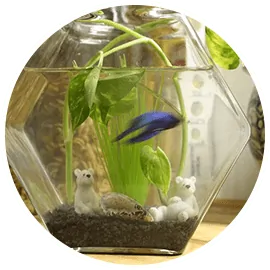
If you’ve visited a pet store before, the above might be confusing. After all, many stores are filled to the brim with all kinds of funky small Betta tanks and bowls, so you’d think it was fine if you didn’t know better. Unfortunately, many people don’t, and pet stores make handy use of this fact. A glass bowl + fish is much less expensive than an aquarium kit + fish, which makes it an easier impulse buy and eventually results in more profit for the store.
Thus, Bettas are handily marketed as a species that doesn’t need or even want a lot of room. As we’ve seen in the previous chapter, this is not true: the wild ancestors of our Betta splendens usually inhabit pretty large habitats. While large open spaces can stress Bettas out, this is no reason to forego a properly sized tank. It just means we have to use plenty of décor, or even stain the water, to offer cover and imitate the natural habitat.
Why are bowls and other tiny tanks such a bad home for your Betta? It’s mostly related to the fact that imitating the high water quality of a large system like a swamp or stream is impossible in such a small container.
No room for a filter or heater.
In many of these small tanks, and especially bowls, there is no room for a filter or heater. As we’ll discuss in Chapter 4, these pieces of equipment are both crucial for keeping your Betta alive, and without them your fish will live a much shorter life. Read more about betta fish lifespan here.
No stable cycle.
The nitrogen cycle (or simply cycle) is what makes it possible for fish to survive in a body of water. Without it, your aquarium water will quickly turn toxic. Unfortunately, even if you do manage to install the filter that should make the existence of a nitrogen cycle possible, the water volume in a bowl or vase is so tiny the water values will never really stabilize. A spike in toxic ammonia or nitrite can quickly happen and severely damage or even kill your beloved Betta.
Large water changes are stressful.
To combat the problem of bad water quality due to lacking filtration or an unstable nitrogen cycle, you’d think you could just do 100% water changes on a more frequent basis. After all, this removes toxic compounds from the water, right? True, but your Betta will not appreciate being subjected to this multiple times a week. Being placed in a temporary container and then having to get used to water values that are suddenly very different is highly stressful to a fish. Stress, in turn, has a detrimental effect on the immune system and can cause disease or even death.
Want to know more about the common myths related to Betta fish housing and why exactly Betta bowls are not appropriate containers? Have a look at the Aquariadise article ‘Why Betta bowls are bad’ for everything you need to know.
Now that we’ve got the unpleasant part out of the way, let’s move on to having a look at what items do constitute a good Betta fish aquarium set-up.

Tip:
Many filters come with activated carbon included in the filter material. This chemical filtration is unnecessary and can actually negatively affect the health of your aquarium when used on a permanent basis, so take the pellets out and fill up the space with biological filter material instead. Don’t throw away the carbon, though! It absorbs chemicals and can be useful if you want to remove medication from the water after treatment.
Aquarium
If you’re gonna keep fish, you’re gonna need an aquarium. That much makes sense, but what kind of tank works best for Betta fish? As discussed in the previous chapter there is a ton of misinformation out there about the best ways to keep these fish healthy. Aquarium size is a widely debated topic, with some sources still recommending bowls and small vases.
So what size should your Betta tank be? In my opinion, at least 5 gallons/19L is needed for long term success, although I personally actually prefer at least double that size. Some will disagree and say that 2.5 gallons/10L is the minimum, but let’s be honest here: that’s tiny. Again, as discussed in Section 3, a small water volume is much more vulnerable to sudden spikes and changes in water quality, which can be very stressful or even fatal to your Betta. Going a little larger can save you a lot of trouble!
A rectangular aquarium is preferable to a square or tall one, as it gives your Betta more horizontal swimming room and makes it easier for the fish to reach the surface and breathe air. Unless you’re planning on going the high-tech aquascape route, a standard aquarium kit that comes with most or all the equipment described below is usually a good choice. The lights and filters in these kits aren’t always amazing, but they should be good enough to keep your Betta healthy.
Aquarium hood
Your Betta aquarium should always have a hood. It doesn’t matter what it looks like as long as it can stop a jumping Betta from being able to leave the tank and end up on the floor, as these fish tend to dash into the air when they’re scared or think they’ve seen something edible, like an insect. Additionally, their labyrinth organ, which allows them to breathe air, doesn’t respond well to a large difference in water and air temperature. A hood ensures warm and moist air stays in so your Betta doesn’t get the fish equivalent of a lung infection! This is also just another reason why an actual aquarium makes a much better Betta home than a bowl.
Filter
The filter is the single most crucial piece of equipment in fishkeeping in general and Betta keeping is no exception. It harbors much of the beneficial bacteria population that allows your aquarium to cycle and become a safe place for your fish. No idea what I’m talking about here? No worries, we’ll move on to the concept of cycling and why exactly a filter is so important later. First, let’s have a look at the different types of aquarium filters out there and their pros and cons in Betta keeping.
Internal filter.
Internal filters are probably the most commonly used filter type. They’re cheap, usually reliable and mostly silent, so they can do the trick. Having this somewhat ugly piece of equipment in their tank is not everyone’s piece of cake, but if you aren’t too concerned with looks an internal filter is a good choice. Choose a filter with an adjustable flow if you can find one, and keep in mind that even then you might end up having to baffle it. Bettas, especially long-finned specimens, don’t deal well with strong water flow and things can easily become too much for them.
Hang on back filter.
A hang on back filter is a good option for those who’d rather have their filter sitting outside of the tank, rather than inside ‘spoiling’ the view. A characteristic of this filter type that comes in handy for Betta keepers is that it releases the water back into the aquarium using a waterfall mechanism, which makes it easy to baffle if the flow happens to be too strong. Downsides of hang on back filters include that they usually don’t have a lot of room
for filter material and their intakes can damage weak Betta fish if you’re not using an intake sponge.
Sponge filter.
Sponge filters are a big favorite among shrimp keepers but not all too popular in the general fishkeeping hobby. They’re air driven, not very powerful and require an (often very noisy) air pump to run. This being said, sponge filters can be useful if you’re looking for something that creates a very gentle flow. Sensitive Bettas with long fins that are easily bothered by stronger filters might benefit from the use of a sponge filter.
Canister filter.
Because Bettas are usually kept in smaller aquariums, canister filters have never really made their way to this part of the aquarium hobby. Although canister filters for nano tanks do exist, these external ‘buckets’ are strongly associated with larger tanks. This doesn’t mean they don’t make a great choice for your Betta tank, though. Canister filters are quite powerful and their design makes them perfect for using plenty of (biological) filter media. Your Betta tank will never be under-filtered if you use one and as long as you use an intake cover as well as (if needed) something to baffle the outflow, this filtration option is fully Betta-safe.

The advantage of using a canister filter is that there is less bulky equipment inside your aquarium. Only the in- and outflow are in the tank, usually in the form of sleek glasswork.
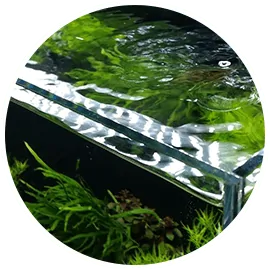
Heater
A heater is an absolute must for your Betta set-up. It keeps the aquarium at an appropriate temperature for this tropical fish species; if you don’t use one, your Betta will become lethargic and usually pass away quickly. Even if you live in an area where temperatures stay at an acceptable level for Bettas year-round, it’s still important to use at least a small heater to prevent possible temperature swings. Air conditioners and sudden weather changes can quickly affect the temperature in smaller aquariums!
There are many different types of heaters on the market, but not all of them are ideal. Remember, this is an electronic device that can cause real trouble if it breaks, so take some time to choose a high-quality brand. Some things to consider and look out for for while choosing your aquarium heater are:
Heater type.
There are a few different types of heaters out there, with the most common being regular thermostat heaters. This heater type is usually tube-shaped with the thermostat placed on top, though some smaller varieties might be round for easier placement. Whatever the shape, this heater type works perfectly well for your Betta as long as it’s high quality. In addition to the commonly used in-tank thermostat heater, there are also filter heaters, heating mats and undergravel heaters. The former is a handy option if you use a large canister filter, though this is usually not the case in a Betta tank. Heating mats are more suitable for terrariums and undergravel heaters are intended to aid in plant growth rather than heating your tank (though their true usefulness is strongly debated).
Wattage.
When choosing a heater, you’ll have to figure out how powerful it needs to be. To make sure you select the right wattage, there’s three things to consider: ambient room temperature, the desired aquarium temperature, water flow and the water volume. If the room your Betta will be in is not too cold (a living room, for example), you can stick to the basic rule of thumb of 2.5-5 watts per gallon of aquarium.
Adjustable or set temperature.
Some heaters are set to a certain temp, but most aquarists prefer being able to adjust the temperature.
Run dry protection.
This is such a lifesaver for me personally. I have the annoying tendency to forget to unplug my heater when doing water changes, which can result in a fried heater and even risks explosion. With run dry protection this risk is minimized because the heater shuts itself off when the water level gets too low, making it perfect for the more forgetful fishkeeper.
Thermometer
As we’ve discussed, Bettas are tropical fish that should be kept in heated water at a stable temperature. Water that’s too warm or cold, as well as swings in temperature, can cause problems. To be able to easily keep an eye on their aquarium temperature and make sure things are still where they need to be, aquarists use a thermometer.
There are a few different types of aquarium thermometers out there, none of them expensive (so there’s no excuse not to get one!). My personal favorite is the LCD thermometer, which has a probe to measure water temperature and displays it on a little screen that sits on top of or next to your tank. I like this thermometer type because it’s easy to read and usually very accurate.
Other thermometer types include strips, which can be difficult to read and are unfortunately often inaccurate, and glass thermometers which usually work fine, but can also be slightly difficult to read.

Standard glass thermometers are still a popular choice.
Photo by Mason Woodward.
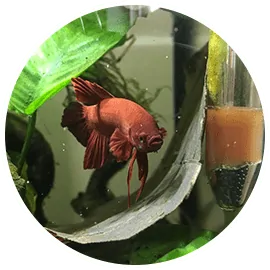
Light
There are a few reasons your Betta tank, and aquariums in general, need a light. First off, all animals require some kind of day and night cycle to function properly. Although light coming into the room through the windows will provide some of this, the tank will still be quite dark without some extra lighting. Placing the aquarium directly in front of a window to combat this might seem like a good idea, but you’ll likely notice that direct sun is a recipe for algae blooms.
In addition to providing a day and night cycle, light is also needed to allow any live plants to photosynthesize and grow. As you’ll read later on in this book I’m a big advocate of plants in your Betta tank, as they offer all kinds of benefits.
Lastly, and quite obviously, if you own a fish you’ll probably want to see it. A light above your tank allows you to keep an eye on your Betta, enjoy its natural behavior, and spot any problems quickly.
A quick Internet search for aquarium lights might leave you shocked: they can be very expensive. Don’t worry, though. The pricey lighting systems you’re seeing are meant for aquascapers who are interested in growing high-maintenance plants.
If you’re not planning on going the aquascape route, you don’t need something nearly as expensive, because there are plenty of low-light plants out there that don’t need such strong lighting. Your Betta won’t like the feeling of a bright spotlight shining on its face all day anyway and actually prefers a relatively dimly lit tank. If your aquarium comes with a stock light this will usually work just fine. Otherwise, you can consider going for a simple LED light kit.
Water test kit
Much of what goes on in your Betta aquarium and affects your Betta’s health is not visible with the naked eye. The water quality can only be determined by testing, which is done using a water test kit.
This test kit is the only way to know whether your tank is safe for your fish and serves as your emergency kit if trouble emerges, so don’t think you’ll save some easy money by not buying one.

Tip:
Additionally, don’t make the mistake of buying a strip test kit. These handy little test strips promise to tell you your water values after being quickly dipped in water, which sounds much more convenient than using a liquid test kit. They’re also cheaper. The downside: they don’t actually work well at all, and they’re more expensive in the long run because you have to use a new one every time. Not ideal when you’re trying to figure out whether your aquarium water is toxic or not.
So, you’ll need to get a liquid aquarium test kit. It should at the least contain tests for ammonium/ammonia (NH4/NH3), nitrite (NO2), nitrate (NO3) and pH. Tests for gH and kH are also useful, but you can always buy these later if you suspect these water values are off. If this all sounds like a foreign language, don’t worry. We’ll dive into the world of water values in Chapter 6.
Water conditioner
Unless you live in one of the very few countries where tap water is naturally free of added chlorine, chloramine or heavy metals, you’re going to need a water conditioner. This bottled product is used to remove all of these compounds, which can be deadly to your Betta fish if not dealt with properly. It’s not difficult to use a water conditioner at all: every brand comes with a manual that will tell you how to use it.
Extras
We’ve discussed all the basic equipment needed to keep your aquarium running smoothly and your Betta happy. There are a few other miscellaneous items that you might want to keep on hand, though. Some you’ll have to buy, others you might already have in your home. Just keep in mind that most of these should be for aquarium use only. For example, you can’t use a bucket for household activities and aquarium cleaning, as you risk introducing dangerous substances into your Betta tank.
Some items that are handy to have in your aquarium cabinet are: a bucket, small fish net, hose (for water changes), scissors, algae scraper, superglue, a spare piece of aquarium sponge (for scrubbing) and airline tubing (for acclimation). It all depends on your own preference though, and you’ll find things piling up as you go.

Tip:
Unsure what plants are best to start out with? This Aquariadise article might come in handy. It covers 8 of the easiest aquarium plants, all of them perfect for beginners and anyone else not wanting to spend too much time and funds maintaining their plants.
Live plants
My personal favorite décor for any aquarium, and especially Betta set-ups, are live plants. I know some aquarists shudder at the thought of trying to keep greenery alive because they’re convinced they have a black thumb, but trust me: anyone can grow plants in their aquarium, even serial (house)plant murderers. It’s a matter of finding the right species and getting the basics right so they can grow. Plants absorb nutrients such as nitrates and help keep your aquarium stable, which means they can actually contribute to your Betta’s health while doubling as much-needed cover. Score!
Still sceptical? A full guide on aquarium plant growing would be too much to cover in this book, but here are three basic tips that should be enough to get you started with low-maintenance plants in your Betta aquarium.
Choose the right plants.
If your goal isn’t to set up a high-tech aquascape, you should avoid demanding plants. Instead, choose species that don’t need a lot of light and will do just fine without regular nutrient dosing or extra Co2. A great choice for Betta tanks would be Anubias barteri, which is very ‘set and forget’ and grows large leaves that your Betta will love to lounge on. You can find a full caresheet for this low-tech favorite on Aquariadise here.
Light, light, light.
All plants need light to photosynthesize and grow. In fact, they need more light than many growers of both house- and aquatic plants might expect. So how do you provide this without breaking the bank? Simple LED lighting kits work perfectly well for the more undemanding species. They’re my favorite choice for low-tech tanks as they’re cheap, don’t use much power and provide enough light to keep your plants happy.
Do some research.
No matter how easy a plant is to grow, it likely still has some specific demands. A quick search can tell you whether there’s anything you need to keep in mind for success with a particular species. For example, Anubias barteri should be tied to porous rock or driftwood rather than planted in the substrate to thrive. Amazon sword, another popular beginner option, will grow significantly better if provided with some root nutrient tabs. Small considerations that make a big difference!

Plants from the Bucephalandra genus don’t need a lot of light or added nutrients and are generally considered ‘beginner-proof’.

Hides & decorations
Even in lush ‘jungle-style’ aquascapes with plenty of plants, many aquarists like to provide their Betta with some additional hides and other decorations that offer cover. There is an endless amount of aquarium décor available, ranging from tacky glow-in-the-dark pink rock formations to all-natural driftwood. Some décor and hide options you can consider are:
Faux plants.
Although, as explained above, live plants are a fantastic addition to your Betta tank, faux plants also have their place. Combine them with live plants for an extra green look or use large-leaved types to provide your Betta with cover and a place to sleep. Just make sure all faux plants you use lack sharp edges that might harm your Betta. Long fins are easily torn! Silk plants without hard plastic pieces work best. Try to avoid very bright colors, as these can be stressful to a species that prefers a calm and dark environment.
Hides and caves.
Your Betta will love one or two cave-style places to retreat to when it feels like it. There are plenty of options: you can try floating Betta logs, sinking cichlid stones or one of the various non-solid ornaments. Just make sure any hollow décor has at least two holes so water can flow in and out. Stagnant water sitting in ornaments can become extremely toxic and might even be fatal to your Betta once disturbed.
Rocks and driftwood.
Looking for something entirely natural? There are many types of aquarium-safe rocks and driftwood available. Fashion rock and wood formations in such a way that plenty of nooks and crannies form for a happy Betta and a natural scape. Don’t use anything you find outside in your Betta tank unless you’re absolutely sure it’s aquarium safe; some types of rock and wood can leach substances that are toxic to aquatic life.
Substrate
Choosing a substrate is an important part of setting up any aquarium, as it determines much of the ‘feel’ of your tank and every type has different advantages and disadvantages. Bettas don’t require a specific substrate type like some other fish do, so you can go ahead and choose whatever suits you.
Choosing a substrate is an important part of setting up any aquarium, as it determines much of the ‘feel’ of your tank and every type has different advantages and disadvantages. Bettas don’t require a specific substrate type like some other fish do, so you can go ahead and choose whatever suits you.
Some plant enthusiasts choose an enriched substrate. A great option if it suits your goals and you know how to use it, though if you want to keep things simple you usually won’t need this. Substrate types that involve capping a dirt-like nutrient soil with sand or gravel are my personal least favorite but are also sometimes used. They make a big mess whenever you move a plant, which is more of a hassle than an advantage in many cases.

Example of a very suitable low-tech Betta aquarium with undemanding plants, fine black gravel substrate and some hardscape.
Photo by Mason Woodward.
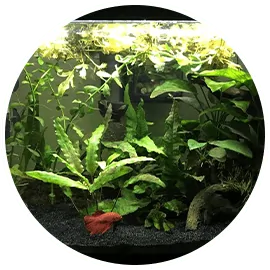

Tip:
Unsure what plants are best to start out with? This Aquariadise article might come in handy. It covers 8 of the easiest aquarium plants, all of them perfect for beginners and anyone else not wanting to spend too much time and funds maintaining their plants.
Initial set-up
There isn’t much more to the initial set-up of a Betta aquarium than placing the tank in your desired spot and filling it up. There are still a few things you might want to keep in mind, though. Having to drain and re-do or even move an aquarium in a later stage is an absolute pain (trust me…) so make sure you’ve thought of everything before turning on the tap.
Placement.
Are your floor and the aquarium cabinet level? Is the tank in a spot that’s not too close to heaters or air conditioners? How about direct sunlight, which should definitely not be hitting your aquarium if you want to avoid creating algae soup? If none of these factors affect the location you were thinking of, go ahead and place that tank!
Preparations.
If you’re going the aquascaping route and have some hardscape (rocks and driftwood) ready, it might be a good idea to try some test layouts before filling up the tank. The placements you might have drawn up on paper in an earlier stage don’t always look the same in the actual tank.
All set and no issues to be seen? Alright, you’ve got the green light to get started. Place a layer of substrate; try not to use too much, just enough to keep your plants in place is a good amount. Position your hardscape. I also like to put my plants in place at this point, especially the carpeting types. Then, very carefully fill up the tank with dechlorinated water and turn on equipment like the filter, heater and light. Voilà! You’ve got an aquarium.
Cycling your Betta tank
After completing the previous stage, many beginning aquarists head out to the aquarium store to buy their Betta. It’s safe to say this is not the best idea: an aquarium is not safe for fish immediately after set-up. Unfortunately a few weeks of waiting is required, during which time you work on getting the nitrogen cycle up and running.
We’ve already briefly touched on this topic in the chapter about Betta bowls. I’ll repeat it one more time for the people in the back: without a nitrogen cycle an aquarium quickly turns toxic and you should never place fish in an uncycled tank. The reason for this is that it’s lacking important beneficial bacteria colonies that should inhabit the filter media and substrate. These colonies convert extremely toxic ammonia/ammonium (NH3/NH4), which is excreted by fish and anything that might be decaying in the tank (like leftover food bits and dead plant leaves), to equally toxic nitrite (NO2) and finally the more ‘acceptable’ nitrate (NO3). This last substance is not nearly as damaging to your fish as the others and will be used by live plants to grow, or removed by you during a water change to avoid excessive levels.
Alright, so you need to get those beneficial bacteria growing so ammonia/ammonium and/or nitrite don’t end up sending your Betta to fishy heaven within a few days of purchase. But how do you go about this? I’ll explain it in short here. If you’re still unsure after reading the short version or just want to know more, just head over to the Aquariadise article on cycling an aquarium, which should contain everything you need to know about cultivating those important bacteria.
Fishless vs. fish-in cycle?
There are two ways to cycle an aquarium. The fish-in cycle is the ‘classic’ one and involves placing fish in the tank which excrete the ammonia needed to kickstart things. Not at all my favorite method, as these fish are exposed to high levels of ammonia and nitrite and might not survive. Instead, we’re going for a fishless cycle here. Easier, faster and better for your fish.
What do you need?
In order to get your Betta tank cycling, all you need is the water test kit you bought during the preparatory stage and a bottle of pure ammonia. Household ammonia without any added scents or surfactants is a cheap option, but if you can’t find it then luckily there are also aquarium brands out there that sell it. Some aquarists like to use pieces of fish food and let them decay in the tank in order to produce the ammonia they need, but let’s be honest here: it’s a little gross.
Add ammonia.
To start your cycle, add about a drop of ammonia per gallon of aquarium water. Your ammonia test should now show visible levels of this compound; keep testing a few times a week. Once the ammonia levels have dropped back to zero, dose again and continue testing. If all goes well, nitrites should start popping up soon as well: a sign things are heading in the right direction. Keep dosing whenever needed until both your ammonia and nitrites drop down to zero and you’re getting a visible nitrate reading. Congrats, you’ve got a cycled tank! Remember to keep adding a little bit of ammonia now and then to keep your beneficial bacteria alive until you’re ready to introduce your Betta. Do a large water change before the introduction to get the nitrates down to an acceptable level (ideally < 10).
Water values
All aquarium fish have specific wants and needs when it comes to the consistency of their water. Some, like guppies, come from hard and basic waters and would like something similar in the aquarium. Others, like Bettas, like their water much less hard and quite a bit more acidic.
Luckily for us aquarists, most commercially bred aquarium fish are very hardy and adaptable. They can survive (and thrive) in quite a wide range or water values, which comes in handy because although things like the pH and hardness can be adjusted, it’s quite a hassle to do so and can result in unwanted swings in water consistency. Don’t go messing about with products like pH Plus or Minus. Swings in pH are almost inevitable if you use this stuff, which is worse than a stable but slightly too high or low pH. If you really want to be able to adjust your water values safely, you’ll have to research this thoroughly before making any changes.
Use your liquid water test kit and thermometer to check your aquarium water before introducing your Betta fish and make sure whether it falls into the acceptable range.
Here’s what you should be looking for:
No idea what all these values mean?
Most water test kits contain a handy leaflet that doesn’t just contain testing instructions, but also explains what you’re actually testing for.
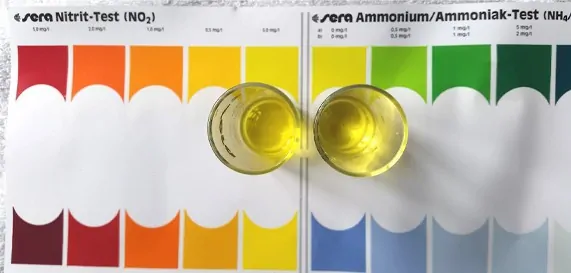
A water test kit is crucial for keeping track of your aquarium water quality. Nitrites and Ammonia/Ammonium should be at zero at all times in a cycled tank.
Like we discussed in Chapter 1, Betta fish are the product of many generations of selective breeding for aggression. Only recently did breeders start to select fish based on color and fin shape rather than feistiness. As a result, the species as a whole is still extremely aggressive. On top of that, species from the Betta complex in general tend to appreciate peace and quiet. They come from dark, calm waters and aren’t used to a lot of activity.
As you’ve probably guessed by now, this combination of aggressiveness and need for a calm environment doesn’t exactly make it easy to find suitable tankmates for Bettas. How do you find something that doesn’t provoke their anger or bother them in the slightest? Some fishkeepers accept the risks and include Betta fish in their community set-ups, but I’m personally a big fan of providing a stress-free environment for all my fish so I can’t support choosing this route.
Although it’s actually easiest to skip the tankmates altogether if you want to be absolutely sure you don’t run into any issues down the road, there are some options if you’d like some extra life in your tank. Just choose wisely, go for quality over quantity, and above all: when in doubt, just don’t do it.
Below we’ll discuss some important guidelines to keep in mind when you’re selecting tankmates for your Betta fish. After that, I’ve included a short list of the species that I feel are suitable and have a very low chance of causing trouble.
Guidelines for choosing Betta tankmates
When putting together your stocking list for any kind of tank, there are many factors you’ll need to keep in mind. If your fish aren’t compatible on all these fronts you’re bound to run into trouble (visible or not) sooner or later.
Betta fish are no exception. In fact, the thinking you have to do in order to pick suitable tankmates is more intense than with most other species, as they’re very specific about their environment and which fish do and don’t trigger stress or aggression. The factors below are some examples of things to think about before heading out to the aquarium store.
Tank size.
First and foremost, always consider the size of your aquarium if you’re considering adding some new fish to your Betta tank. After all, most Betta set-ups aren’t too spacious. If you’re going for tankmates you’ll need something relatively roomy; unless we’re talking invertebrates, stick to a minimum tank size of about 20”/50cm (this comes down to about 15 gal/54L). Anything less and things might get a little too cramped for the tankmates in question. Additionally, you should always research the minimum aquarium size for the particular fish species you’re interested in. If your tank is too small, then you’ll have to find an alternative.
Water values & temperature.
One mistake many (new) fishkeepers make when making a stocking plan is not paying enough attention to what the fish in question want their water to be like. In this case, they have to be able to handle Betta fish water values: relatively soft and acidic as well as quite warm.

Tip:
The above excludes a few popular Betta tankmate choices like White Cloud Mountain Minnows, which are actually coldwater fish and will be miserable in a toasty Betta tank.
Environment.
In the same category falls the fact that you’ll have to pay some attention to what your tank looks like and which fish match that. The aquarium should be densely planted, relatively dark and without too much water flow to keep your Betta fish happy. Any tankmates will have to come from similar waters, or they’ll end up stressed. For example, avoid species that hail from fast, clear-water streams without much vegetation!
Water layer.
Betta fish are top dwellers, which means they spend most of their time near the surface and would like to keep this space to themselves. Logically, this means that fellow top dwellers don’t make ideal tankmates. Bottom feeders are a much better choice, as they stick to the lowest water layer and your Betta will barely see them.
Color and fin shape. As we’ve discussed a few times now, Betta fish are bred to respond extremely aggressively to anything that looks like another Betta fish. Contrary to popular belief, this applies to both male and female Bettas. When choosing your tankmates this means that anything that even slightly resembles a Betta fish is out of the question. Color plays a large part in this, as do long flowy fins. Fancy guppies, colorful gourami and anything else that is either colorful, long-finned or both, will likely end up being bothered and nipped at relentlessly. Not good!
Temperament.
Although Betta fish are quite feisty themselves, they absolutely don’t appreciate tankmates with a similar temperament. Active and/or assertive fish are bound to stress your Betta out, which can eventually result in declining health. Unfortunately this factors out a lot of popular tropical aquarium fish. A school of tetras? Too active. Guppies? Too active (and, as mentioned, too colorful). Barbs? Too assertive.
Plan B.
So you’ve miraculously managed to find a species that ticks all the boxes above? Awesome! All Bettas are different though, with some just being unsuitable for tankmates altogether due to their aggression level. What this means is that you always need a Plan B in case things just don’t work out. Ask the aquarium store about their return policy or have an emergency tank or tub ready to go. Even if a Betta isn’t hiding or chasing tankmates it might still be stressed out, so keep an eye on things at all times. If the fish is frequently showing horizontal stress stripes across the body, going pale and clamping it’s fins, it’s probably time to seriously reconsider your stocking choices.
Short list of Betta tankmates
After reading the previous paragraph you might be wondering if there are any fish species at all that meet the complicated requirements for Betta Tankmate Suitability.
Well: there aren’t many, but there are a few. Opinions on which fish work for Bettas vary, but here is a (relatively conservative) list of species that pose a low risk of trouble. There is not enough room to discuss all of these in detail, but you can click on the links to their respective caresheets if you’re interested and want to learn more.
Amano shrimp.
Shrimp, with the exception of the occasionally bothersome ghost shrimp from the Palaemonetes genus, make good Betta tankmates. They are entirely peaceful and play their part in keeping your aquarium clean by consuming leftover foods and algae. Go for a larger species such as Amano shrimp, though, and always remain vigilant. After all, Bettas are naturally insect eaters and some have a stronger hunting instinct than others. You’ll need a tank over 10 gallons/38L to house a small group of Amano shrimp. Want to know more? Head over to the Amano shrimp caresheet on Aquariadise.
Snails.
Another great Betta tankmate option that doubles as a cleaning crew are snails. Examples of small snail species that can be kept in aquariums of 5 gallons/19L and up are Nerite snails, assassin snails and Malaysian trumpet snails. As with shrimp, keep an eye on things to make sure the snails aren’t continually harrassed by your Betta. Want to learn more about the different types of snails that you can keep in your aquarium? You can read all about them in this article.

Nerite snails make a good tankmate option… if your Betta leaves them alone, that is.
Betta by chunso on Flickr (CC BY 2.0)
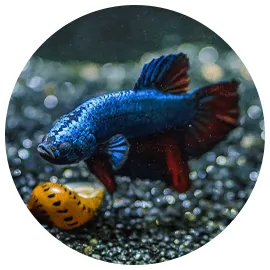
Kuhli loaches.
As discussed under ‘Water layer’, bottom feeders make good Betta tankmates because the two species will rarely run into each other. The snake-like Kuhli loach is a good example of a fish that lives almost its entire life on the substrate and is inconspicuous enough to escape your Betta’s attention. Interested in keeping Kuhli loaches? You’ll need an aquarium of at least 20 gallons/75L with plenty of floor space and a sandy substrate. Get a group of at least 8 loaches and provide lots of hiding places in the form of tubes, caves and plants. If you want to know more, head to the Kuhli loach caresheet on Aquariadise.
Corydoras catfish.
Like Kuhli loaches, Corydoras are friendly bottom dwellers that won’t bother your Betta in the slightest and will not attract its attention. Although they are a little more active than Kuhlis, the fact that they reside in an entirely different water layer should prevent problems. There are many different types of Corydoras out there. The tiniest species are referred to as Pygmy Corydoras and are a Betta tankmate favorite (you can find more information about keeping them in their caresheet on Aquariadise). Larger Cories will need a little more room and work well in bigger set-ups.
Otocinclus catfish.
The tiny Otocinclus is appreciated by aquarists for its algae-eating capacities and combines well with your Betta because it spends most of its time sitting motionlessly on plants or decorations. A seemingly perfect choice, but unfortunately you’ll have to skip this one unless you’re an experienced aquarist with a stable and established set-up. Otocinclus are very fragile and need consistently high water quality. You can find a full caresheet here.
Harlequin Rasbora.
Now, I’ll start off by saying I wouldn’t personally combine a Betta fish with any schooling species that inhabit the middle water layer. That being said, though, many other aquarists keep their Bettas with harlequin Rasboras without any apparent issues. The combination seems successful because the Rasboras don’t move around too much, lack long fins and aren’t as brightly colored as, say, neon tetras.
Choosing a tail type
Betta breeders have selectively bred their stock for years to produce all sorts of tail types and lengths. It’s become a bit of a sport to own Bettas with the longest, flowiest tails possible – but at what cost to the fish? Let’s have a quick look at the most common Betta tail types (divided into short, long and extreme) and their pros and cons.
Short-tailed Bettas.
These Bettas are closest to their original form: wild-form Betta splendens have relatively short tails. Short-tailed Bettas are referred to as ‘Plakats’ and their tails can have every possible shape. You’ll find Plakats with halfmoon tails (180° spread), double tails, crown tails, rose tails and more. Plakat Bettas are my personal favorites because their short tail doesn’t slow them down or cause health issues like fin biting, rot or fin ray breakage. Some might find them a little less spectacular than long-tailed specimens, but I much prefer a zippy, active fish to one that spends most of its time resting! Be sure not to confuse male Plakat Bettas with female Bettas. Like Plakats, female Bettas have short fins, but they can be told apart by their rounder belly.
Long-tailed Bettas.
The most common long-tailed Betta type is the veiltail, which has a long, flowy tail that hangs down like a veil. Most standard pet store Bettas are veiltails.
As with Plakat Bettas, long-tailed Bettas can have many other tail shapes as well. Some varieties that don’t exist in Plakats are the delta tail, which is somewhere between a veiltail and a halfmoon tail, and the rare roundtail. Long-tailed Bettas are bred for being pretty, not functional. The fish you buy at your local aquarium store are often still young and vigorous, but they might slow down a lot once they age. You’ll have to provide plenty of resting spots for your long-tailed Betta and be prepared to possibly deal with issues such as fin biting.
Extreme Bettas.
There are two Betta tail types that I personally classify as ‘extreme’ and would strongly recommend against. These are the rosetail and the even more extreme feathertail, both of which feature excessive branching in the tail bones that gives a ruffly effect. Rosetail and feathertail Bettas have become quite popular in recent years and breeders have started producing them in large amounts to keep up with the demand, each trying to breed an even more heavily branched tail. But at what cost? The rosetail and feathertail gene appear to come with inherent health issues. Additionally, these fish have such heavy tails that branch breakage and fin biting are almost inevitable. Many spend most of their time lying down on the substrate because they’re just not able to swim normally anymore. Want to know more about rosetails and feathertails? This article on Aquariadise details the issues with these tail types.
Want to read more about all the Betta tail types out there? You can find a full article discussing each type in more depth on Aquariadise here.

Some Betta keepers prefer short-finned Bettas because they feel that long finnage impairs a Betta’s quality of life
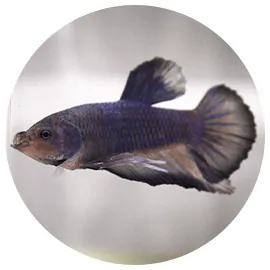
Pet store, import or (hobbyist) breeder?
Most Betta enthusiasts buy their fish at the local pet- or aquarium store. Because Bettas are so popular, most stores carry a pretty wide range of colors and tail types nowadays, which means there’s a Betta for everyone.
One downside of buying your Betta from the aquarium store is that it’s almost guaranteed to be a mass-bred import, which means you have no clue about its genetics and whether the fish came from a responsible breeder. This can be a problem, especially if you’re interested in breeding your Betta: you have no idea how the fry will turn out. Breeding pet store Bettas is therefore strongly recommended against, as all sorts of heritable diseases and other undesired traits can pop up.
For those who’d like to know a little more about the background of their Betta there are two other options. You can go online and head to a website like AquaBid.com, where breeders auction off their finest stock. Because you can speak to the breeder directly, you can often gather a lot more information than you would get when buying a pet store Betta.
My personal favorite way to find a Betta is to buy from a (hobbyist) breeder. There are many Betta lovers throughout the world who are extremely dedicated to breeding the best possible Bettas that are healthy and conform to show standards. Many have spent years trying to perfect a certain color or tail type and will be able to tell you all about the fish you’re buying – as well as its parents and grandparents! Although Bettas from breeders are not necessarily longer-lived or better than pet store Bettas, you at least know what you’re buying. Not sure where to find a breeder? Try Facebook or a local aquarium show that has a Betta stand.
Finding a healthy Betta
Although it’s impossible to guarantee you’re buying the healthiest Betta in the entire store (genetic issues can unfortunately pop up at any time), there are some precautions you can take. Most of these apply to choosing fish in general.
Activity level.
Bettas found at your local aquarium store can be a little sluggish, especially if they’re kept in cups. There’s still a good way to check their response to stimuli, though: try asking the store employees for a mirror. A healthy Betta (even females!) will respond immediately to its own reflection. It’ll flare its fins, try to swim towards the ‘opponent’ and might even extend its gills to appear larger.
Check for external damage.
Have a very close look at the fish you’re interested in buying. Use some extra light if you need to. The eyes should be bright and there should be no signs of any of the following: injuries, tail rot, fungus or signs of disease or parasite. No idea what to look for? We’ll discuss common Betta diseases and their outward symptoms in Chapter 11 on troubleshooting.
Inspect the store.
hen buying any fish I like to take a good look at the rest of the aquarium store I’m at. Not only does the condition of their tanks and stock tell you a lot about the circumstances your possible future Betta has lived in until now, I also try to avoid low-quality stores altogether because I don’t want to fund their business.
It’s not too alarming if there’s a dead fish or two present in the store; shipping and being moved are very stressful to any animal and there can be casualties after receiving a new shipment. Tanks containing sick fish are also a possibility for the same reason. Red flags include many dead or dying fish, dead fish that have clearly been left in the tanks for a long time, infected tanks that are not labeled ‘quarantine’ or ‘not for sale’, incompatible fish in the same tanks and the sale of inappropriate tanks like bowls. The presence of many Bettas that seem to have swim bladder issues (floating or sinking) can also be a warning sign, as this is often caused by extreme stress. It often resolves by itself in a stress-free environment but can be a sign that you might be best off skipping the store in question.
Baby Bettas.
One trend that seems to have been increasing in popularity over the past few years is the sale of baby Bettas. This seems like a good idea: breeders have to spend less money raising their fish and you get to see your fishy friend grow from a little bean to a proud and colorful adult. An easy impulse buy for sure, as baby Bettas definitely are quite cute. In reality, though, you’re unfortunately best off avoiding baby Bettas. Raising a baby fish is a lot of work, as they need very frequent feedings and the best possible circumstances to grow to a healthy adult. In many cases they’re already been exposed to so much stress and bad water quality that your baby Betta project is very likely to end in disaster. I personally avoid buying babies so I don’t support this less-than-ideal practice.

A healthy Betta will respond (sometimes quite strongly!) to stimuli.
Draco by ravelda on Flickr (CC BY-NC 2.0)
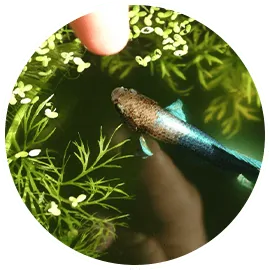
Adopting a Betta
When someone says ‘adopt, don’t shop’, you’re probably thinking of cats and dogs rather than fish. Don’t be fooled into thinking you have to buy a Betta from a store, though. You can still adopt!
As we’ve discussed, Bettas are a popular impulse buy. Many people eventually get bored of having to take care of a fish or realize it’s more work than they thought. A simple search on any classifieds website will probably turn up Bettas (and other aquarium fish) looking for a new home.
Keep in mind that many Bettas are kept in sub-par conditions. If you buy a fish that has been in a little unheated bowl with dirty water for months, you’ll have to realize that it is unlikely to be healthy. Adopting a Betta might therefore not be ideal if you don’t have any experience in keeping fish yet, as there’s a good chance you’ll have to nurse your new addition back to health before being able to enjoy it. Adopting is great, sure, but be prepared to set up a fish ER and spend additional funds on medication as well as a lot of time doing water tests and water changes. It’ll be worth it in the end, though!
Natural Betta feeding pattern
Bettas’ upturned mouths reveal a lot about their natural diet: they are insect eaters that have adapted to pick bugs off the water surface and other spots. Our Betta’s ancestors consume foods like mosquito larvae, unfortunate insects that have entered the water, worms and almost anything else they can find. If it wiggles, a wild Betta will (try to) eat it.
What we can conclude from this is that these micropredators need a diet that’s high in protein. They’ll consume some plant-based foods if resources are scarce, but it’s not their first choice.
Choosing a staple Betta food
Much of what goes on in your Betta aquarium and affects your Betta’s health is not visible with the naked eye. The water quality can only be determined by testing, which is done using a water tesImitating a wild Betta’s diet exactly is a difficult task, which is why most aquarists choose to feed their fish high quality staple foods that contains similar nutrients instead. These daily pellets or flakes* are then supplemented with all sorts of other snacks, which we’ll get into below.
What boxes does a commercial fish food need to tick to be suitable as a daily staple for a Betta fish?
*Some sources list flakes are bad for Bettas and aquarium fish in general, but this is not necessarily the case. It’s just that very few flake brands actually tick the right boxes so they’re usually better off avoided.
Floating.
Bettas naturally tend to search for foods in the upper water layers. In the aquarium you’ll find that your Betta will easily miss any sinking foods once they’ve hit the bottom of the tank. Because we don’t want our Bettas to go hungry, nor do we want decaying bits of food all over the tank, it’s a good idea to find a type that floats.
Small.
Many commercial fish foods are designed for fish that are a little larger than the tiny Betta. Find something with a small grain size to avoid problems.
Protein-based.
As we’ve discussed, Bettas are carnivorous and need a high-protein diet. Unfortunately not all commercial foods that are marketed as suitable for Bettas actually meet this need: plants are cheaper than proteins, so some brands like to skimp on the actual meat content. Not good! To find a high-protein Betta food you’ll have to get used to closely scrutinizing the ingredient list of any brand you’re considering. Is the first ingredient a plant? Might want to skip it. Most Betta keepers agree that any ingredients that are listed as specific and “whole”, like “whole salmon”, are better than meals without specific info such as “fish meal”. A generic meal is still better than a plant based ingredient or plant meal, though.
Low on fillers.
The ideal ingredient list for a Betta food would be relatively short and contain many whole specific meats. In reality, though, many manufacturers unfortunately use more plant-based fillers than is ideal as this keeps production cost low. Although you’ll always see some kind of vegetarian content like wheat on the ingredient list (otherwise it would be impossible to produce an actual pellet), it shouldn’t dominate. If you see a lot of plants like wheat, rice, corn or soy at the top of the list then you might want to go for something else. These fillers aren’t good for your Betta in high amounts and can be indicative of a low-quality food.
Adding variety to Betta diet
Now that we’ve gotten the rather boring task of choosing staple foods out of the way, it’s time to add a little more variety. There are many non-pellet foods out there that your Betta will love to snack on, which you can use to make sure it gets all the nutrients it needs. My personal top choices are:
Live food.
Hands down your best option. There are many live fish foods out there that are extremely similar to what a Betta would eat in the wild. Hunting these little critters provides good exercise – not to mention how fun it is to watch your Betta go wild trying to catch its food. You can buy live food at the aquarium store, but as this introduces the risk of parasites it’s usually the best idea to hatch or cultivate your own foods. Sounds like a daunting task, but it’s really not that bad. Set up a simple brine shrimp hatchery, cultivate some yummy blackworms (instructions here) or even buy some wingless fruit flies at the reptile department if you want to keep things really simple. Toss in a few bugs at a time and let the hunt begin!
Frozen food.
Almost all pet- and aquarium stores will have a freezer containing various types of frozen worms, larvae and other tiny bugs that make a perfect Betta snack. These can be stored for a long time, so I always have a few different blister packs in the freezer. The separate frozen blocks are much too large to feed your Betta at once. You can thaw a single block and keep it in the fridge to feed throughout the week, although you might end up having to toss part of it to prevent it from going bad. Alternatively, you can carefully cut off part of the block and thaw this in a little water to make sure the ice doesn’t hurt your fish.
Gel food.
What if you could make your own fish food that contains the exact ingredients your Betta needs? Well, you can! A commonly used method to DIY fish food is to make gel food. This involves blending the foods you want to feed your fish together to a nice and nasty mix and then binding this with gelatin or agar agar.
Freeze in batches and thaw when you want to feed. Although gel food can be a little messy, especially if you accidentally use too little gelatin, it’s definitely something to try if you want to know what goes into your Betta’s mouth. You can find a full guide to creating your own gel food on Aquariadise here.
Feeding frequency & amount
You might have heard the common myth that you should feed your Betta as much as it can consume in X minutes. Despite the fact that even some fish food manufacturers include it on their food packaging, this advice is just that: a myth. If you feed your Betta as much as it can eat in five or even just two minutes, you’ll end up with a very fat fish very quickly. Fish don’t know when they’re full, so if you keep feeding your Betta will keep eating, even if its stomach is about to burst.
Feeding frequency.
You can feed your Betta between one and three times a day with spaces of at least a few hours between every feeding. You could try to average two feedings a day. Remember that if you feed more often, it’s a good idea to make the portions a little smaller than if you would feed only once.
Portion size.
I like to feed my Bettas one to three pieces of food (pellets, worms, etc.) at a time, with a maximum of 6 pieces in one day. The exact amount per feeding moment depends on how often I’m planning to feed in a day and what the fish ate the day before.
Variety.
Be sure to switch up feeding frequency, portion size and what you’re feeding day by day. That means you might feed three times on Monday (2x pellet at 8am, 2x thawed bloodworm at 2pm and 1x pellet at 9pm) and only once on Tuesday (a portion of live food at 3pm).

Tip:
Still want to know more about the best Betta feeding practices? You can find an even more in-depth article on the topic on Aquariadise: Betta food & feeding.
Weekly maintenance
Weekly Betta tank maintenance includes the most important task of doing water changes. By removing part of the aquarium water and putting clean, dechlorinated and temperature matched water back in you remove excess nitrates, as well as other substances like phosphate. This is very important to your Betta’s health, so never skip a water change even if you’re having a busy week!
In addition to providing a day and night cycle, light is also needed to allow any live plants to photosynthesize and grow. As you’ll read later on in this book I’m a big advocate of plants in your Betta tank, as they offer all kinds of benefits.
It’s pretty easy: just test the aquarium water right before doing a water change. How high are the nitrates?
- If they’re under 5, you’re in the green zone and don’t have to do a large water change. I like to still change around 10% if this is the case though, just to be sure.
- If the nitrates are between 5 and 10, they’re still unproblematic but it would be nice to get them to 5 or lower. Change 10-20% and see where they’re at now.
- If you find your nitrates are > 10, a good water change is in order to get them to at least under 10 and ideally under 5. Change 20% and see what that does. Still not in the green zone? Change 20% again the next day.
This all seems like a lot of work, but the nice thing is that if all factors stay consistent then your nitrates usually will as well. If they’re consistently at 10 by the time you have to do a water change, week after week, you’ll eventually have a pretty good idea of how much you need to change every week. At this point testing so often is not needed any more: you’ve figured out your ideal water change schedule. Do make sure not to forget about testing entirely. Keeping an eye on your Betta’s water values is always good practice, especially before doing a water change.

Keeping your Betta’s tank clean is crucial to its long-term health.
Fighting To Be A Betta Fish! by tjt195 (CC BY-NC 2.0)
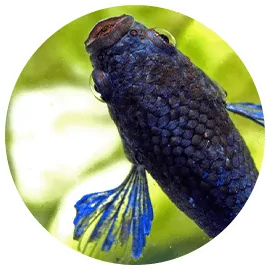
Cleaning
The weekly water change is the perfect moment to do some tank cleaning. Water is usually removed using a siphon, which you can also use to ‘vacuum’ the bottom of the tank and remove any debris that might have collected. Algae cleaning and plant pruning is best done before you remove the water, because it allows you to remove particles that come loose immediately.
Biweekly maintenance
As mentioned in the intro of this paragraph, Betta tank maintenance is more than just water changes. It’s also important to make sure your filter keeps functioning properly by regularly removing debris that collects in the sponges over time. Filter cleaning doesn’t have to happen weekly, especially if your aquarium isn’t heavily stocked, but biweekly or at the very least monthly cleaning is a good idea.
Cleaning your filter is not a lot of work. It’s best done during a water change: simply remove a bucket of water from the tank, take the sponges out of the filter and squeeze ‘n squish them in the bucket until dirt stops coming out. If there is a layer of filter floss in the filter you can replace that if it’s dirty, as it’s usually difficult to clean and doesn’t contain a lot of beneficial bacteria anyway. Leave biological filter material alone so you don’t disturb the bacteria in there. That’s it! You can now put the filter back together, refill the tank with clean water and turn it back on.

Tip:
TheFilter sponges don’t last forever. Although you shouldn’t regularly replace sponges entirely like some filter manufacturers suggest, it’s not uncommon to eventually hit a point where new sponges are needed.
If the filter outflow seems weak even after cleaning the sponges, they have probably just soaked up too much dirt over time that can’t be removed anymore and are possibly starting to break down. You can handle this problem by replacing half of the sponge now and the other half after a month or two. This prevents cycle crashes and ensures a constant presence of beneficial bacteria.above excludes a few popular Betta tankmate choices like White Cloud Mountain Minnows, which are actually coldwater fish and will be miserable in a toasty Betta tank.
Maintenance checklist
Must dos:
- Feed Betta (daily)
- Remove uneaten foods (daily)
- Check water temperature (daily)
- Check if Betta looks and behaves normally (daily)
- Water change (weekly)
- Substrate vacuuming (weekly)
- Filter cleaning (biweekly)
- Test water values (at least biweekly)
Optional:
- Algae scraping (weekly, biweekly or monthly)
- Plant pruning (weekly, biweekly or monthly)
Water quality problems
One thing to always keep a very close eye on is your water quality. This applies to fishkeeping in general, but to Bettas in particular because the average Betta tank is not exactly huge. Small water volume means a greater risk of water quality problems, so be sure to always keep your test kit close by.
Prevention.
Regularly test at least ammonia, nitrite and nitrate to ensure the aquarium is still fully cycled. Avoid making large changes in your aquarium: never replace all filter media at once, do large water changes without acclimation or add water of a different temperature. Slow and steady wins the race. Additionally, it’s not a good idea to try to alter your pH or water hardness unless you know exactly what you’re doing. Products like “pH down” or “pH up” do more harm than good in most cases. Stable water values are usually more important than perfect water values!
Troubleshooting.
A listless Betta is often the first sign of water quality trouble, so be sure to immediately test your water if anything seems off. If this results in the conclusion that the nitrogen cycle has become disrupted (ammonia or nitrite > 0), it’s time to put the “emergency water quality plan” into action. After all, as discussed earlier both ammonia and nitrite are very toxic. Any amounts present should be dealt with right away.
The first thing to do when you encounter pretty much any problem in any aquarium is a water change (between 25-50% works well to start with). Adding fresh water brings the concentration of damaging substances down. The addition of a detoxifying water conditioner like Seachem Prime can make the water safe again for your Betta, but unfortunately it will only bind ammonia, nitrite and nitrate temporarily. You have to keep adding it to keep the water non-toxic and make sure you fix the underlying cycle problems.
Now, there isn’t a ton you can do about cycling issues aside from waiting it out while doing daily water changes (25% a day) and possibly adding a detoxifying conditioner. There is one thing that might prove helpful in speeding up the process so everything runs smoothly again, though: dosing bottled bacteria. There are various brands out there and yes, contrary to what some aquarists think, they do actually work if used correctly. Make sure the product hasn’t passed its expiry date and is kept refrigerated, though.
Sick Betta fish
Unfortunately, as with all organisms, there is a whole range of different ailments that can affect your Betta fish. All are a pain to deal with and many can quickly become fatal. Being able to diagnose Betta diseases and figure out the right treatment as soon as possible is important, but discussing all possible illnesses in-depth would take a book of its own. Instead, I’ve included a table with a short description of the symptoms and preferred treatment for the most common diseases that can affect Betta fish to help you identify any issues so you can research them further yourself. Before going into disease and diagnosis, though, let’s discuss prevention first. Although it’s impossible to reduce the possibility of having to deal with a sick Betta to 0% there are a few measures you can take to at least lower the risks.
New Betta.
The risk of encountering Betta illness is highest right after you buy your fish. After all, the stress of transport and resulting lower immune system, combined with the possibility of infection through tankmates or a shared water system, can take a real toll on a Betta’s health. That’s why you should always take a very close look at any fish you consider buying and skip specimens that look or behave out of the ordinary. Having to immediately set up a fish ER, trying to get a diagnosis and finding the right medication is not exactly the ideal start, and there’s no guarantee you’ll be able to save your new fishy friend.
Water quality.
Bad water values are probably the most common cause of a sick Betta once the fish has settled in. Trace amounts of ammonia and nitrite due to a tank that’s too small or improperly cycled, high amounts of nitrate due to a lack of water changes or swings in pH and temperature cause a big strain on your Betta’s immune system. Problems like fin rot, pop-eye and even highly deadly dropsy (all described below) can all pop up as a result. Thus, keeping your aquarium stable and clean is one of the best things you can do for your Betta’s health!

Bad water quality in an uncycled tank or bowl can quickly make your Betta sick.
IMG_7138 by portablematthew on Flickr (CC BY-NC 2.0)
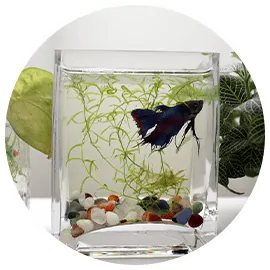
Cleaning
Stress prevention.
Stress, especially chronic stress, can be very damaging to the immune system. You can prevent most causes of stress by following the guidelines described in this book. Just to name a few: the aquarium should be densely planted with a gentle filter flow (and it should not be a bowl, vase or bottle) and your Betta
should not be exposed to bad tankmates and especially not other Bettas. Any changes to the tank should be made slowly to avoid shock.
A proper diet.
Everything you should know about Betta food and feeding can be found in Chapter 9 on feeding your Betta. As discussed there, a Betta’s diet should contain high quality food and be as varied as possible. Why? Without the nutrients its body needs, a fish will slowly waste away. Its immune system can eventually start to fail, with all kinds of diseases as a result. Invest some time in choosing good Betta foods and regularly switch things up with some (live) bugs and other treats.
Common Betta diseases
| NAME | CAUSES | SYMPTOMS | TREATMENT |
|---|---|---|---|
| Bacterial infection | Bad water quality, lowered immune system | Red streaks in fins, lethargy, sores | Antibiotic, high water quality |
| Columnaris | Often secondary, highly contagious; gram-negative aerobic bacteria | Cotton mouth, fuzzy spots and lesions | Thoroughly clean aquarium, kanamycin & furan-based antibiotics |
| Constipation | Overfeeding, feeding of inappropriate foods | Distended stomach, no poop | Fasting, possibly a small feeding of Daphnia |
| Dropsy | Stress; organ failure due to bacterial infection | Fluid retention (body swelling & scales ‘pineconing’) | Almost always deadly; kanamycin is sometimes recommended |
| Fin rot & body rot | Bad water quality, previous injury; gram-negative bacteria | Frayed fins with red or black edges; can progress to body | NO salt. Improve water quality, possibly antibiotics that treat gram-negative bacteria |
| Flukes | Gill parasites | Rubbing/flashing against objects, breathing issues | Praziquantel |
| Fungal infection | Bad water quality, previous injury | Cotton-like fuzzy patches on the body | Anti-fungal medication |
| Ich | Parasites | White “salt grains” on the body, clamping, rubbing on objects | High water temperature, aquarium salt, possibly formalin or malachite green |
| Pop-eye | Bad water quality; can be a symptom of bacterial infection | Swollen eye(s) that appear to almost pop | Improve water quality, possibly antibiotics |
| Slime disease | Various parasites; stress | Excessive white-ish slime coat | Aquarium salt, malachite green/copper sulfate |
| Swim bladder disorder | Damaged swim bladder or bacterial infection; can be difficult to pin-point | Fish is unable to maintain its balance | Swim bladder might be permanently damaged, but might also heal by itself or need antibiotics |
| Tuberculosis | Infectious bacterial infection | Open sores, bent spine, rot; progresses very quickly | Euthanization. WARNING: disinfect entire tank and all equipment. Can infect humans. |
| Velvet | Parasites | Appearance of gold dust on the fish, clamping, rubbing on objects | Raise water temperature, turn off lights, malachite green/copper sulfate |
Fin biting
In their quest to breed the most spectacular Bettas, breeders have produced all sorts of outrageous fin types. If you’ve bought a beautiful rosetail or halfmoon Betta it can be quite the disappointment when the fish decides to simply… bite off its tail. Not in the least because although the fin will grow back, it usually won’t look as good as it used to. The real problem, though, is that damaged tails are prone to issues with rot.
Why do long-tailed Bettas bite their fins? No one is really sure, but it’s likely a combination of frustration caused by lugging around the heavy tail, stress, boredom or even hereditary factors. In some cases the nipping can be stopped by reducing stress-factors, reducing light levels and adding more décor to distract the fish. You can never be sure this will actually help, though. The only foolproof solution seems to be to avoid long-finned Bettas entirely and go for short-finned plakats or females instead.
Tumors
Unfortunately, there’s always a risk of your Betta developing one or multiple tumors, which might eventually require you to humanely euthanize the fish. There is some consensus in the Betta world that certain man-made Betta varieties have a higher chance of tumor growth, though. Dragonscale, marble and koi Bettas are known for their beautiful coloration, but sadly the same genes that are responsible for their spectacular looks are also the suspected cause of their frequent issues with tumors.
Blindness
Unfortunately, there’s always a risk of your Betta developing one or multiple tumors, which might eventually require you to humanely euthanize the fish. There is some consensus in the Betta world that certain man-made Betta varieties have a higher chance of tumor growth, though. Dragonscale, marble and koi Bettas are known for their beautiful coloration, but sadly the same genes that are responsible for their spectacular looks are also the suspected cause of their frequent issues with tumors.
Bettas with diamond eye can live out their lives normally, but you might have to take some measures to make sure they can find their food. Some aquarists like to soak food for blind Bettas in water with some added garlic, as this has a strong smell that makes it easier for the fish to locate their meal.

An example of a dragonscale Betta that likely suffers from impaired vision.
DSC_3651 by gomagoti on Flickr (CC BY-SA 2.0)


An aquarium with plenty of nooks and crannies to explore helps keep your Betta active and healthy.
Plakat super red dragon by jellyfish_killer on Flickr (CC BY 2.0)
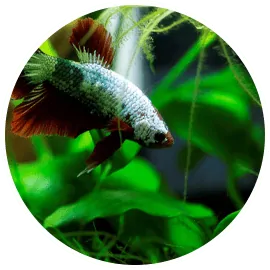
Fin biting
Now, even after reading through all these chapters you might still have some uncertainties. After all, if I wanted to describe every minor detail that comes into play when keeping Bettas or fish in general, we probably would have ended up with an almost unreadable monster of a book. To make sure you don’t run into unexpected issues that weren’t discussed here I’ve set up a Facebook group just for readers of this book. It’s called Aquariadise Betta Keepers and you can find it here.
To join, all you have to do is enter our ‘secret password’ in the confirmation box that pops up to verify you’re a reader. Once you’ve been approved you can use the group to ask questions about everything Betta, share photos of your own (new) Betta aquariums and interact with fellow group members.
Password: Betta Than a Bowl
Thanks for reading! I wish you all the luck with your next fishkeeping project. If you’re preparing to set up your very first tank, just remember to take things slow and don’t be afraid of making mistakes: they’re a part of learning in any hobby. You’ll be an expert aquarist before you know it.
Oh, and PS…
I hope you feel like this book helped you on your journey to become the best possible Betta owner. If it did, I’d like to ask you for a little favor: can you help me continue to spread the word on Betta care and review this book on Amazon?
You can click here to be taken to your personal Amazon review page and start writing.
Thanks a ton and, again, good luck!















